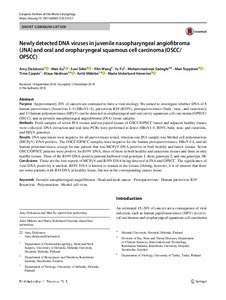Newly detected DNA viruses in juvenile nasopharyngeal angiofibroma (JNA) and oral and oropharyngeal squamous cell carcinoma (OSCC/OPSCC)
Amy Dickinson; Man Xu; Suvi Silén; Yilin Wang; Yu Fu; Mohammadreza Sadeghi; Mari Toppinen; Timo Carpén; Klaus Hedman; Antti Mäkitie; Maria Söderlund-Venermo
https://urn.fi/URN:NBN:fi-fe2021042821234
Tiivistelmä
Purpose: Approximately 20% of cancers are estimated to have a viral etiology. We aimed to investigate whether DNA of 8 human parvoviruses [bocavirus 1–4 (HBoV1–4), parvovirus B19 (B19V), protoparvoviruses (bufa-, tusa-, and cutavirus)] and 13 human polyomaviruses (HPyV) can be detected in oropharyngeal and oral cavity squamous cell carcinoma (OPSCC/OSCC), and in juvenile nasopharyngeal angiofibroma (JNA) tissue samples.
Methods: Fresh samples of seven JNA tissues and ten paired tissues of OSCC/OPSCC tumor and adjacent healthy tissues were collected. DNA extraction and real-time PCRs were performed to detect HBoV1-4, B19V, bufa- tusa- and cutavirus, and HPyV genomes.
Results: JNA specimens were negative for all parvoviruses tested, whereas one JNA sample was Merkel cell polyomavirus (MCPyV) DNA positive. The OSCC/OPSCC samples were negative for the human protoparvoviruses, HBoV1-4, and all human polyomaviruses, except for one patient that was MCPyV DNA positive in both healthy and tumor tissues. Seven OSCC/OPSCC patients were positive for B19V DNA, three of them in both healthy and cancerous tissues and three in only healthy tissues. Three of the B19V DNA-positive patients harbored viral genotype 1, three genotype 2, and one genotype 3B.
Conclusions: These are the first reports of MCPyV and B19V DNA being detected in JNA and OPSCC. The significance of viral DNA positivity is unclear. B19V DNA is known to remain in the tissues lifelong, however, it is of interest that there are some patients with B19 DNA in healthy tissue, but not in the corresponding cancer tissue.
Kokoelmat
- Rinnakkaistallenteet [27094]
